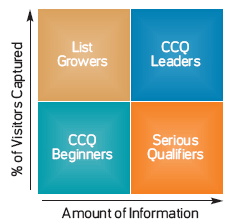Mastering Customer Capture on Your Website

By Steve Castro-Miller and Ryan Allis
A savvy e-tailer's work is never done. Everything from effectively managing pay-per-click (PPC) campaigns, optimizing for search, blogging, integrating social media efforts and continually refreshing content is on the to-do list. But it all really boils down to making every visitor count.
Websites should make every effort to move prospects through the sales cycle, but as important - if not more so - is to optimize the site for information capture. Some visitors, for example, will not purchase right away, but they are not less important. Every time a well-qualified prospect lands on-site and leaves anonymously, the website - and all its underlying technological wizardry - has failed. The more we can learn about our site visitors, the better we can optimize for tomorrow's prospect.
CONTACT CAPTURE QUOTIENT
To frame this discussion and to act as a strategic tool for businesses, we introduce the concept of the Contact Capture Quotient (CCQ). A website's CCQ is the measure of a website's success in capturing visitors' contact data. A website with a CCQ of one captures complete information about 100 percent of its visitors. Websites will differ in their informational needs but a website's CCQ will, at any given time, fall into one of the four categories described below.
LIST GROWERS: Websites that require limited information in order to maximize the percentage of visitors captured. List Growers are typically only capturing one or two pieces of information such as name and e-mail.
CCQ BEGINNERS: Websites that capture a low percentage of visitors and little information about them. This might include the visitor's name, e-mail address, business name, and maybe basic demographics like age and gender. This type of website is likely to have several form fields without requiring completion of all of them. These websites "take what they can get" from visitors.
CCQ LEADERS: Websites that excel at capturing a high percentage of visitor data, and robust information about them. They use multiple methods of collection in multiple locations throughout the website. They want data that will allow them to place someone well in the sales cycle. They find out if a person is the decision-maker, and who might know the purchasing timeframe. They may even learn about budgets and use live chat to ask more questions.
SERIOUS QUALIFIERS: Websites that capture detailed information about a relatively small percent of visitors using automated and/or human touch methods to collect information. They want specific information from only the most qualified prospects. An auto dealer, for example, will want to know about the website visitor's existing car (appraisal), and what other car dealers the person is considering so they can combat the competition. If the website has a business- to-business focus, they will want to know about how the decision-making process works, and the RFP process.
 CCQ is similar to SEO in that it does not have a mathematical formula that fully describes it, but it does purport a relative ranking. Business owners will find it useful to determine both their present and desired locations in the quadrants above because the integration of live chat software and email marketing will dramatically improve any website's CCQ.
CCQ is similar to SEO in that it does not have a mathematical formula that fully describes it, but it does purport a relative ranking. Business owners will find it useful to determine both their present and desired locations in the quadrants above because the integration of live chat software and email marketing will dramatically improve any website's CCQ.
INTEGRATING LIVE CHAT
Forms are one way to capture user information but nothing can compare with an actual conversation with your customers. And that's where live chat comes in - it provides real insight into products, our clients and how we service them during critical stages of their interactions with our brands.
With live chat, consumers not only feel connected to our brands, but can also get access to key information during the decision- making process. All the while information can be collected about the visitor - are they more concerned with product guarantees or cost? In addition, the website owner can begin to understand how the website is performing, where roadblocks exist, the effectiveness (or lack thereof) of product descriptions, and so on.
Depending where live chat is accessible to the user (an 'about' page, next to the shopping cart, etc.) and its usage, site owners can target the most effective place to engage a consumer. All of this information can be used to build user profiles and drive business decisions.
Another consideration is repeat visitors. Are they more likely to give additional information? It's possible, if the visitor is already familiar with and trusts the brand. If so, website owners can develop business rules through some live chat software that will indicate when a repeat visitor is on the site. Site owners can then reach out to them through a proactive chat.
E-MAIL CHAT
E-mail is one of the most cost-effective marketing methods available. It's cheaper than traditional bulk postage mail, often has a much larger impact on immediate sales, and allows buyers and sellers to build a relationship based on value and trust. Email can also be used for deeper, more personal interaction.
With offerings that make it easy to insert HTML into e-mail content, it's possible and advisable to include a live chat button in e-mail campaigns. It's a powerful way to further the website/consumer relationship and encourage future e-mail deliverability and click-throughs. For some, it can even out-perform other clickable links inside the e-mail. E-mail chat can also help determine those messages that are the most effective - or least effective - at providing a desired response.
USING PROACTIVE CHAT
Once the user has navigated from your e-mail to your website, keep the conversations going. Visitor monitoring data can be used by a proactive chat rules engine to engage website visitors in real time. Based on a visitor's behavior, geographic data, or other information, website owners can proactively offer someone the opportunity to engage in a live chat. So, if a website visitor located in Houston is on your website, you might be able to engage a live chat session that is relevant to their location - perhaps offer local business coupons or notify them of a store near their home they don't yet know about. Proactive campaigns regularly see take rates of their invitations at well over 20 percent.
ANALYZE YOUR VISITOR DATA
Using a live chat offering, you will learn something about your visitors. This data - as impersonal as it may seem - can be aggregated into useful information. The goal of this data is to identify changes that will increase your site's CCQ. Consider the following scenarios:
- You may have a content relevancy issue if visitors who arrive on-site from a particular keyword tend to engage you in chats, but don't agree to be added to lists for follow-up.
- Change your chat operator incentive plans to account for longer chat sessions if they result in better contact capture. Many companies push operators to reduce the time they spend with customers, in order to control overhead.
USE AUTORESPONDERS AND ANALYTICS
Don't wait if someone agrees to have their name added to your house list. Immediately set up an autoresponder series that gives them instant gratification by delivering one or more e-mails containing relevant and robust content. Additionally, use whatever reporting facility enables you to analyze internal e-mail clicks, forwards and opens.
Integrating live chat and e-mail marketing influences each phase of the click cycle and, when considered together, can work in concert to raise a website's CCQ. A website's ability to build ongoing relationships with visitors is a big key to long term monetization; whether that is the sale of goods and services directly to visitors, or the sale of advertising impressions based on their visits.
About the Authors: Steve Castro-Miller is the president and CEO of Bold Software, who provides live chat among other services. Ryan Allis is the CEO of iContact Corp.








